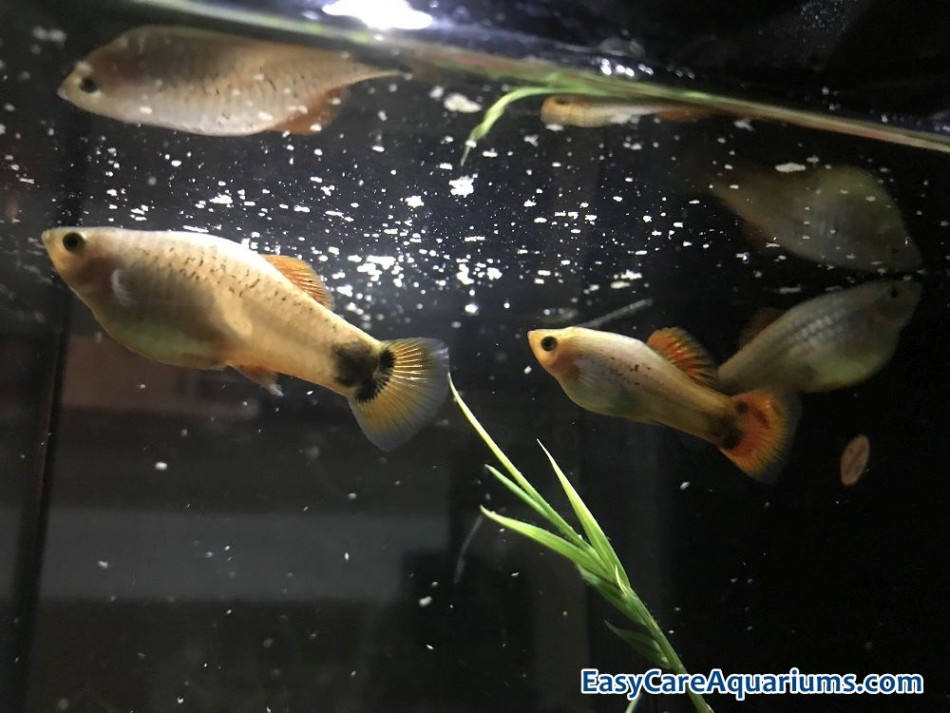This article may contain some affiliate links to products. The links provide me a small percentage of commission but do not cost you anything extra to use. (See full disclosure statement here ).
).
When I first got my baby Platy fish I was new to the fishkeeping hobby. I realised that I still had a lot to learn but I wanted to give my Platys a good diet to keep them happy and healthy.
But what do Platy fish eat? What exactly is a Platy fish diet?
While doing a little research I came across some interesting tips about how to feed my Platys a surprisingly varied, and healthy diet.
So basically . . . . . . . .
Platys are an omnivorous fish. Which means they are happy to eat a variety of meat and vegetable based foods. This makes the Platy easy to feed. They do well on a mix of meat and plant based foods. The meaty (protein) side of their diet can include: insects, tubifex worms, blood worms and small crustaceans such as brine shrimp. And When it comes to the vegetables, courgette (zucchini), cucumber and lettuce are all acceptable on the Platy menu, along with other veggie options too. Platys will also be happy to dine on flake food, which can be used as the staple part of their diet.
With so much choice and flexibility in the Platy diet what exactly should you be feeding your Platy?
And is a variety of foods really that important?
So Why Is Variety Important In A Platy Fish Diet?
Feeding your Platys a diet that contains both protein and vegetables will keep them happy and healthy.
And there’s a couple of good reasons for this.
- Firstly a diet that combines protein and vegetables will keep your fish’s immune system healthy. So you’ll have less chance of your Platys developing a disease and becoming ill or dying prematurely.
- Secondly a varied and complete diet is important for normal growth and development. If you feed your Platys the right combination of nutrients you should end up with a strong, healthy and lively Platy community in your aquarium.
This may sound like hard work. Particularly if you’re new to keeping Platys. But it doesn’t have to be hard work at all.
You can keep it simple.

Basic Platy Diet
Food flakes are a great way to provide an easy and nutritious staple for your Platy fish’s diet.
A good quality flake food should contain a mix of plant and protein based ingredients. Along with other beneficial additions such as the appropriate vitamins and minerals for Platy fish. This means that you can use pre-prepared flake food as the basis of your Platys’ diet.
Always buy a good quality one though and check that it contains both meat and plant derivatives. The ingredients need to be all natural too.
Feeding dried food flakes to your Platy is an easy and a non-messy way to do it. And if it’s good quality flake food your Platys can thrive well on this type of food alone, if that’s what you choose to do.
But What’s The Best Flake Food For Platy Fish?
As I’ve just mentioned, flake food is the ideal starting point when it comes to the basis of your Platy’s diet.
But what kind of flake food should you choose?
Here’s some tips about different types of flake foods.
Can Platy Fish Eat Goldfish Food Flakes?
This is something that I wanted to know myself because goldfish flakes are readily available and, for the most part, inexpensive. It’s easy to buy a big pot of goldfish flake food even from your local supermarket. But will Platys eat them and do they provide a good diet for Platy fish?
The simple answer to whether your Platys are likely to eat them is ‘Yes’. When it comes to whether goldfish flake food will provide your fish with a nutritious diet, the answer is a little more complicated.
Goldfish flakes often have a high cereal content along with the protein and vegetable content. So it’s important to choose a goldfish flake food that has enough vegetable and protein (e.g fish/crustaceans) but a minimum of cereal content.
This means that goldfish food that contains a lot of cereal, rice in particular, should be avoided when it comes to feeding your Platys. Even if you’re supplementing their diet with other food stuffs a high cereal content is generally not a good idea in a Platy diet.
If you have a community aquarium with other types of fish that thrive well on goldfish flake food, and you don’t want to buy several different pots of flake food, just be sure to buy a good quality goldfish flake that contains enough vegetables and protein to satisfy your Platys’ needs.
Can Platys Eat Tropical Fish Food Flakes?
Even though a lot of Platys are happy to live in a temperate tank they are actually small tropical fish. So flake food designed to meet the nutritional needs of tropical fish are an acceptable staple for the Platy diet.
The same rule applies to buying tropical flake food as it does to choosing a suitable goldfish flake for your Platys. Check the proportion of vegetables and protein to give your Platys a healthy diet and make sure the food is of good quality.
Fluval, Aquarian, King British and Tetra are all reputable brands when it comes to flake foods So it’s worth checking them out when you’re choosing tropical flake food for your Platys main diet.
Can Platys Eat Temperate Fish Food Flakes?
I adopted my Platy fish from my son. He’s got a large temperate community tank with several kinds of non-aggressive fish that all live happily together. And his Platys, being prolific breeders, decided to increase the population of the community aquarium by producing lots and lots of baby Platy fry.
The staple diet of all the fish in the aquarium was Love Fish Temperate Food Flakes.
Because my Platys had been reared on this I’ve continued to buy the same temperate flake food. I pick it up at my local Pets At Home store, or if I’m short on time, I order it from their website.
It’s a reputable flake food that’s packed full of good stuff to keep temperate fish healthy. And because my little fish were happy and healthy on this one I decided to keep it as the staple part of their diet.
If you can’t get the Love Fish Temperate Flakes where you live then check out some of the other reputable brands I’ve just mentioned above in the Tropical section as they supply a range of fish foods.
But what about adding some extra nutrition and variety into your Platys’ diet?

How Can I Supplement My Platys’ Diet?
In addition to a good quality flake food it’s a great idea to top up the nutrients and vary things a bit.
After all, no one wants to eat the same thing day in and day out. It’s not only boring but vital nutrients can be missed out.
Protein Treats
To keep it easy for you, but nutritious for your fish, you can include:
- Tubifex Worms
- Blood Worms
- Brine Shrimp
- Daphnia
All of these are good sources of protein.
I was advised by a friend of mine who’s kept fish for years to use dried, frozen or freeze-dried worms and shrimp. Apart from being less messy than the fresh variety you also reduce the risk of introducing bacteria and parasites into the aquarium. Both of which can be a risk with fresh worms and shrimp.
How often you vary your Platys’ diet will depend on you and your fish. But remember that you’re varying their diet, not adding to it. You don’t want to overfeed them. Just feed them well
Keep reading for some easy ways to add extra veg into your Platy’s diet.
What Vegetables Can I feed My Platy Fish?
Platys love their veggies so there’s a wide choice of vegetables that you can try.
You’ll probably find that your Platy fish prefer some types of veg over others. And there may be some that they’re not interested in at all.
So you will need to experiment a little over time.
This doesn’t mean that feeding your Platys some extra veggies will end up being expensive though. You can prepare a little of the veg that you buy regularly anyway as a treat for your fish.
Here’s a few ideas for some vegetables that you can offer to your Platys
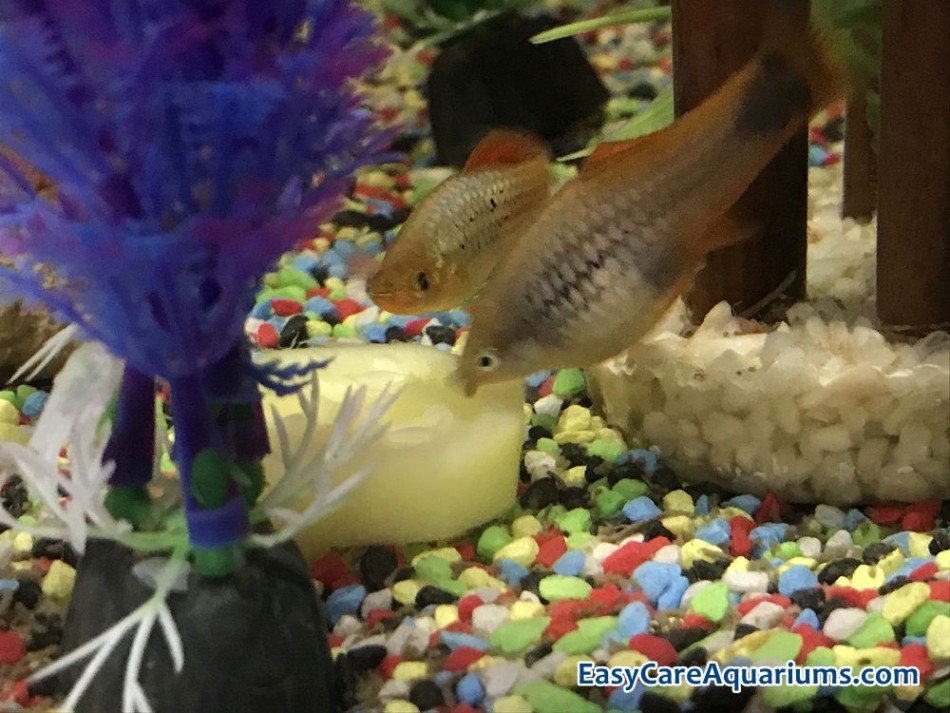
Veggie Treats
- Courgette (Zucchini)
- Cucumber
- Lettuce
- Kale
- Broccoli
- Peas
You can also offer them other Green Leafy Vegetables, Sweet Potato and Squash. And even, occasionally, a little bit of fruit such as Apple or Pear.
But how do you prepare vegetables so your Platy fish can eat them?
Take a look below for details of how easy it is to feed your Platy fresh veggies
How To Prepare Fresh Vegetables For Platy Fish
Courgette (Zucchini) And Cucumber
- Wash the courgette or cucumber in clean water. I also peel mine as the skins can still be a little tough for my Platys to eat even after cooking.
- Slice courgette/cucumber (the thickness is up to you but cutting slightly chunky slices helps them to sink to the bottom of the tank)
- Put the courgette/cucumber slices into a pan of boiling water on the hob. Turn down the heat and simmer for 1-2 minutes to soften the courgette/cucumber. My Platys prefer them quite soft so I leave them simmering until they are almost ‘cooked’. You’ll have to experiment a bit to see what your Platy fish prefer.
- When cooked, strain off the water. You can either put the slices into cold water, or allow them to cool naturally on a plate. Putting them into cold water stops the cooking process more quickly. So if you don’t want your slices to soften further after cooking then this is the best way to cool them down.
- When cooled you can pop a slice or two of the courgette/cucumber into the aquarium. They should sink to the bottom but if you have some that won’t sink just try using a different slice.
Lettuce
Tip: Don’t use the outer leaves. This helps to avoid pesticide contamination (even if you buy organic lettuce this is still a good idea).
- Wash the lettuce leaves in clean water
- Put leaves into a bowl of boiling water and leave for 1-2 minutes to soften them.
- Remove the lettuce leaves and either put them into cold water to cool or allow them to cool naturally on a clean plate.
- You will need to weight the lettuce down in the tank by using the aquarium ornaments or a clip/weight that’s suitable for aquarium use.
There are different varieties of lettuce available so you may find that your Platys like some and not others. My Platy fish will only eat the standard ‘Round Lettuce’ and definitely don’t like the Iceberg lettuce. They totally ignored it!
Kale And Broccoli
Both kale and broccoli take a little longer to soften than some of the other veg because they naturally have a tougher consistency. So you will need to simmer them for a bit longer to make them soft enough for your Platys to eat.
But the principle is the same.
Follow the instructions above for preparing courgette (zucchini) and cucumber (minus the slicing part). And adjust the cooking time to suit your Platy’s tastes.
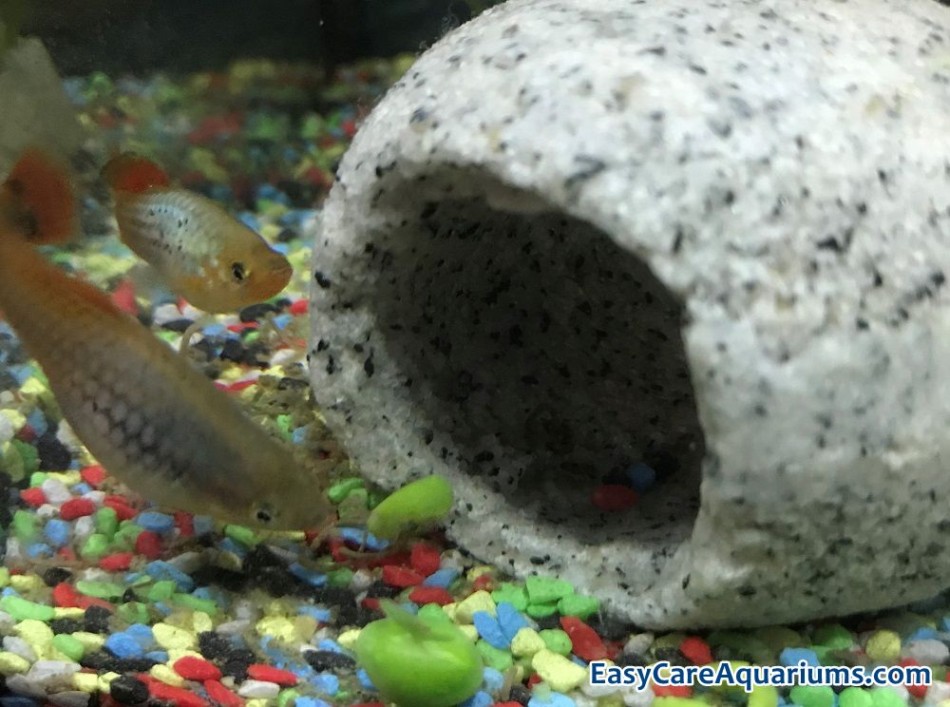
Peas
Peas are another easy to prepare vegetable that Platy fish enjoy.
Tip: Split open the softened peas a little so your Platy fish can get at the softer inside more easily.
- Gently simmer the peas for 1-2 minutes until softened slightly. Or simmer until they are soft enough for your Platys to happily eat.
- Strain off the water. Cool in cold water or allow to cool naturally on a clean plate
- The peas usually sink to the bottom of the tank. But scoop out any that float at the top unless your fish are happy to feed on them there.
N.B: You can also use a microwave or steamer to soften vegetables and fruit for your Platys.
Can You Use Frozen Vegetables To Feed Platy?
Yes, frozen veggies are fine for Platys.
I’ve found it best to defrost them thoroughly first to reduce cooking time. Soften them by simmering (or microwave or steam) and then cool them down in the same way as you would for fresh vegetables (see above).
How Long Should You Leave Vegetables In A Platy Tank?
How long you can leave vegetables in an aquarium will depend on the type of vegetable that you’ve added and how soft they already were when you added them to the tank.
Some vegetables naturally take longer to disintegrate than others due to their composition. Courgettes (zucchini) for example, hold together longer than sweet potato, or peas that have been split open.
There’s no hard and fast rule about how long you can leave a particular veggie in the tank.
But it is important to use a commonsense approach.
Here’s a rough guide to help you to decide
- Don’t leave any vegetables in the tank for more than 24 hours
- The more tightly compacted veggies stay when cooked the longer they will take to fall apart in the aquarium. So veg such as courgette and cucumber hold together a lot longer than sweet potato and squash.
- It’s a good idea to remove any leftover vegetable matter as soon as your Platy fish have had their fill. So if after a couple of hours or so you think they have had enough take out the leftovers.
- If you feed your Platys before going to work, or being out for most of the day, make sure you choose a more ‘solid’ vegetable for them to nibble on during the day. Otherwise you may well come home to a very dirty and cloudy tank. Which means that your evening will be spent on tank maintenance instead of relaxing.
Why Is It Important To Remove Uneaten Vegetables And Food From An Aquarium?
The problem caused by leaving any leftover vegetables,fruit and even food flakes in a fish tank basically comes down to decay.
Rotting plant and food matter not only makes the tank look dirty but it also pollutes the water.
A build up of gases from the decaying leftovers, and the general reduction in water quality, will be harmful for your Platy fish. Decaying plant and food matter creates a greater risk of disease and the possibility that some, or all, of your fish will die.
So keeping on top of your tank maintenance and removing any uneaten food is really important.
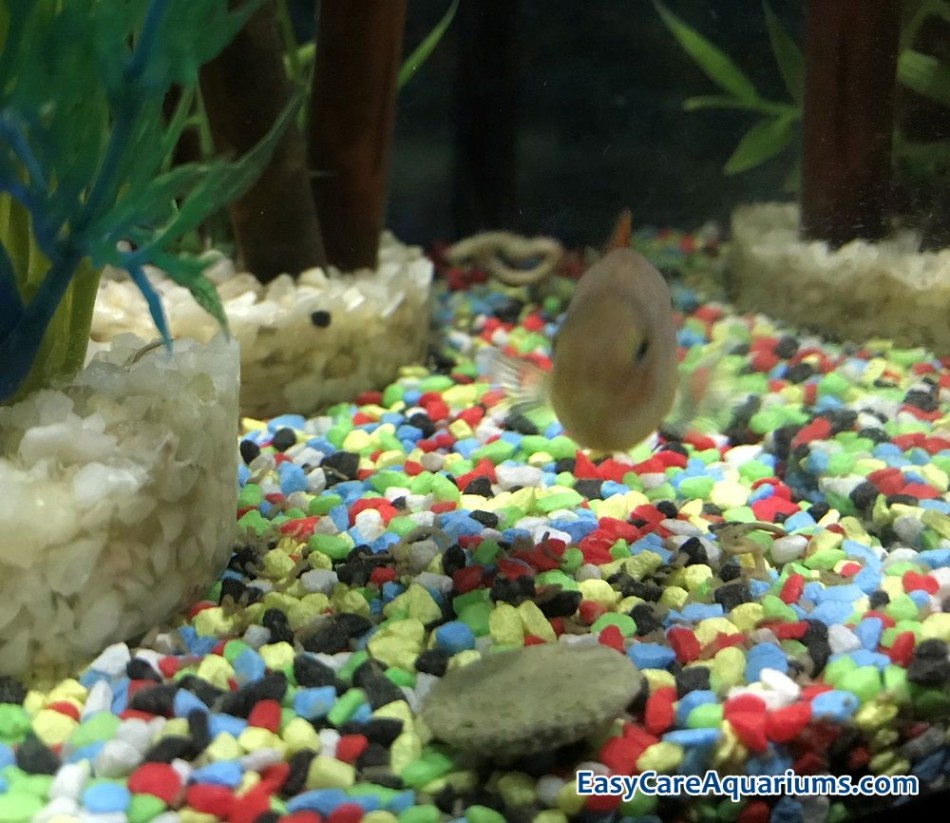
Do Platy Fish Eat Algae?
Algae, as I’ve discovered, is something that needs to be kept under control. Although it’s natural for algae to grow in an aquarium, too much of it is a bad thing.
There are different types of algae that will grow naturally in your tank. Some are good in moderation and some not so good.
Even though Platy fish do eat some types of algae, they’re not the kind of fish that you add to your aquarium as algae eaters in an effort to keep the algae under control.
Your Platy will happily nibble away at the algae that develops in your tank. But, because the Platy is an omnivorous fish, algae alone will not satisfy your Platy’s appetite and all nutritional needs
So you need to keep the tank environment clean and healthy. This includes not only the water quality, but also the substrate (gravel), plants, glass sides and tank ornaments. In fact anything at all that is inside your aquarium.
By doing this you will keep on top of algae growth and your tank will provide an attractive and healthy environment for your fish. Click here to read about how snails can help keep an aquarium clean.
to read about how snails can help keep an aquarium clean.
Algae Wafers
Just because you need to keep your aquarium environment clean, and control algae growth in the tank, doesn’t mean that you can’t treat your Platys to some algae..
I’d seen Platys really tucking into an algae wafer. And I thought it was a great way to feed some algae to my fish without overwhelming the tank with green stuff.
So I bought my Platy fish a pot of King British Algae Wafers.
I’ve obviously got some really picky eaters. Because despite trying them with the algae wafers several times they showed no interest at all.
Then one of my female Platys, she’s the largest Platy in the tank, decided to have a little nibble on the algae wafer.
This made little bits of algae float around the tank. My other Platys were delighted about this and started to mop up the floating algae.
After a few mouthfuls they decided to find out where the tasty snack was coming from.
And it didn’t take them long to find the source of the food.
Finally, after several attempts on my part, they were all eating the algae wafer. And enjoying it too. I was really pleased that they had taken to eating it. Particularly since I still had most of the pot left and I didn’t want to waste them.
However, I did notice something strange about the behaviour of my Platys in between bites of algae wafer.
They were positively hyperactive.
They were chasing each other around the tank at full speed and pushing each other out of the way to get to the algae wafer. Even my large male Platy, who is always a laid back fella, was darting about and making sure he got a nibble of algae too.
It was like I’d given a group of small children a large chocolate bar each and let them eat it all at once!
I’m so pleased that my Platys like the algae wafer as algae is a natural part of their diet.
You’ll probably find that your Platys love the algae wafers too. Hopefully they’re not as picky as my lot are and start to enjoy them a bit sooner than my Platy fish did.
Don’t forget to remove the leftover wafer once your Platys have had enough or you will end up with a dirty tank and extra tank maintenance.

Do Platy Fish Eat Live Plants?
I have to admit that I don’t have live plants in my tank. My tank and my Platys are temperate and the plants are artificial.
But please bear with me on this one.
I do know that tropical tanks benefit from having live plants. Live plants in a tropical aquarium help to improve the water quality. And at the same time they create an attractive and a more natural environment for the fish.
The same goes for live plants in a temperate tank.
So if you have Platys in either a tropical or a temperate tank, with lots of lovely live plants, will your Platy fish eat them?
I can’t speak from experience on this one. But because I would love some live plants in my tank I checked it out.
This is what I found out about Platys and live plants
The main thing I realised was that the answer to the question ‘Do Platy Fish Eat Live Plants?’ was a Yes and No answer.
It seems to depend on personal experience and the personality and tastes of your own Platy fish.
There seems to be a general agreement about Platys eating algae and tiny bugs/insects off the plants. Which is not surprising as the Platy fish is omnivorous and loves both veggies and meaty things.
It’s when it comes to eating the plants themselves that people’s opinions tend to differ.
Some Platy keepers say their fish don’t eat the actual plants and some say they eat the plants to destruction.
While I couldn’t track down specific aquarium plants that Platys definitely eat I did come across a general theme.
The aquarium plants that seem to get eaten most often are of the soft leaf variety. Juicy tender leaves appear to be at a higher risk from a hungry Platy intent on a snack. The tougher, courser leaved plants seem to be less of a target for Platy and so are more likely to be left alone.
So if you don’t want your Platy fish to strip the leaves off your plants, making your tank look like a wasteland, then choose the tougher, coarser types of aquarium plants.
You’ll stand a better chance of your plants surviving this way. Although with the Platy fish there is no guarantee.
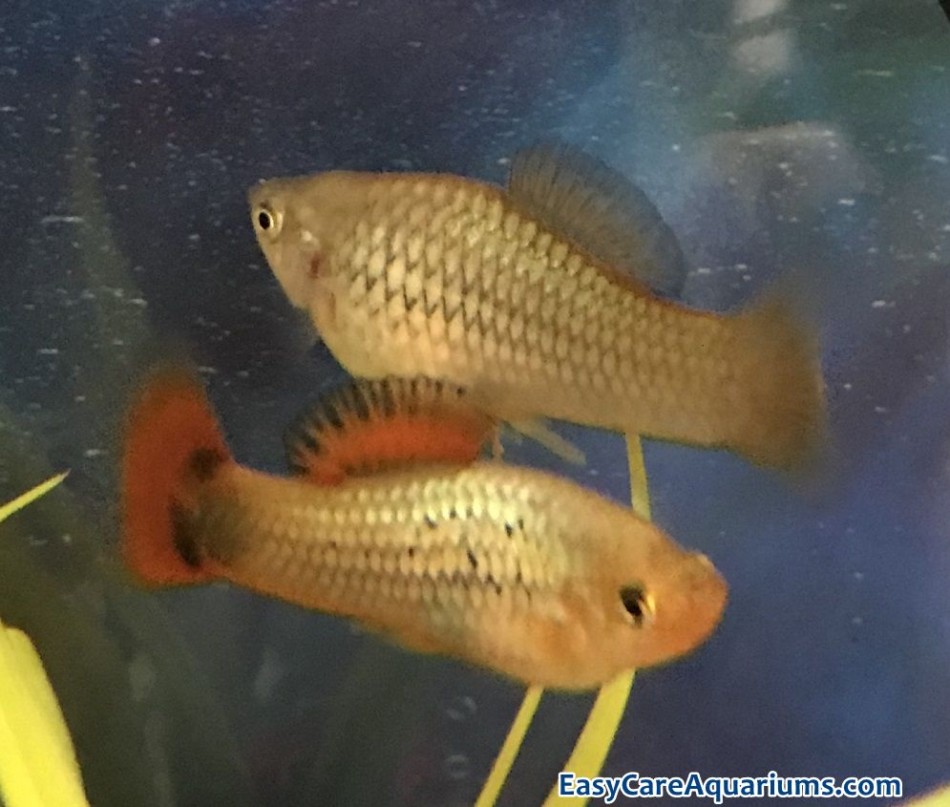
Will Platy Fish Eat Other Fish?
Platy fish are a non-aggressive community fish which means they don’t attack and kill other fish for food.
That doesn’t mean that they won’t eat other fish though. The Platy is a rather greedy little fish and is always ready for an impromptu snack.
It’s been known for Platy to nibble at a fish that has died in the aquarium before the owner has had a chance to remove the dead fish. Whether the fish died of natural causes, or was attacked by a more aggressive fish, makes no difference to a Platy when it spots a tasty morsel.
Platys also eat their own young (fry) because they lack a protective instinct when it comes to their own offspring, or anyone else’s for that matter. The tiny wriggling little fry are considered fair game to the adults when it comes to finding a meal.
Good quality flake food also contains fish derivatives along with other nutritional ingredients and vitamin and mineral supplements. In fact fish food flakes generally smell like fish and usually provide the staple part of a Platy’s diet.
So yes, Platy fish will eat other fish.
Just because they don’t actively kill other fish for food they won’t pass up the chance of a little extra protein in their diet. Even if that protein comes from someone who used to be a tank mate or a close relative.
What Do Baby Platy Fish Eat?
Baby Platy fish (fry) are as easy to feed as the adults are. They will eat the same food as the adults. But it’s helpful to the fry if you break down the food into smaller pieces. This will give the fry a chance to eat their meal.
You can use powdered dry food formulated for livebearing fish if you like. Or you can just scrunch down your normal dry flake food into tiny pieces. It’s easy to do. You just scrunch it down in the palm of your hand into tiny powdery-sized pieces before putting it into your aquarium.
If you want to supplement your baby Platys’ diet just be sure that any brine shrimp or daphnia are the newly hatched ones and that any veggie additions are of an appropriate size for the fry to eat. Again, it’s important to avoid contamination in the tank from bacteria and parasites. So frozen or freeze-dried protein is often the best option when it comes to the meaty protein part of their diet.
You can also top up the protein content of your Platy fry’s diet by feeding them a little boiled egg yolk paste.
Just mash a small piece of boiled egg yolk into a paste and drop it into the tank. This works best if you’re keeping your fry in a separate tank from the adults. Egg yolk paste is too fatty for the adult Platys so it’s not a good idea to add it to a mixed tank. And because the paste is messy you need to remove the leftovers quickly once the fry have finished feeding off it or you’ll end up with a cloudy, unhealthy aquarium.
Fry are pretty tough so they do tend to manage well when it comes to getting their share of the food. But if you want to save as many baby Platys as you can, make sure some of the food you add to your aquarium at meal times is small enough for the fry to eat. Also give the fry lots of places to hide away from the adult Platys in the tank until they grow big enough to fend for themselves.
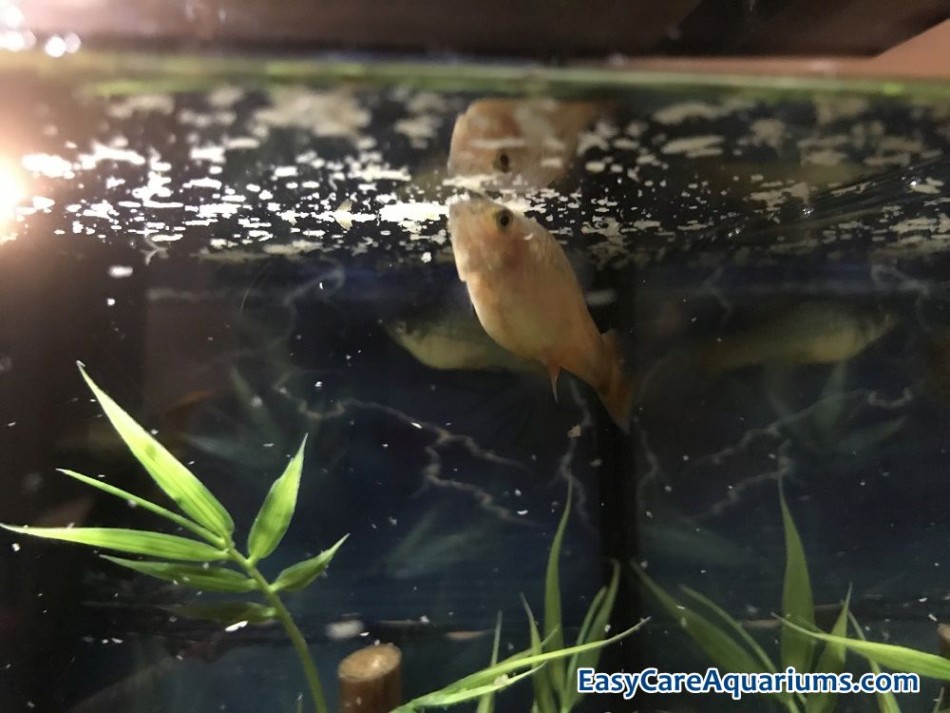
How Much And How Often Should I Feed My Platy Fish?
How much and how often you should feed your Platys is another one of those areas in the fishkeeping hobby that I’ve found to be open to opinion based on the Platy keepers personal experience.
How Much Food Do My Platy Fish Need?
As a general guide though, you should feed your Platy fish as much flake food as they can eat within about 3-5 minutes.
If you vary your Platys diet with other things, tubifex worms or brine shrimp for example, the same basic rule applies.
The guidelines are a little different for adding vegetables and fruit to the tank. There’s some advice on this in the ‘How Long Should You Leave Vegetables In A Platy Tank?’ section above.
You do have to take into account that your aquarium filter will suck up some of the smaller, lighter food before your Platys get the chance to eat it. And also that Platys always seem to be looking for more food even if they’ve just been fed. It’s easy to be tempted into giving them a bit more because they seem to be begging you for a dessert. As I mentioned earlier, Platys can be rather greedy. Which makes it easy to overfeed them.
It’s all a bit trial and error at first but you’ll soon get to know whether you’re feeding your Platys the right amount. Don’t panic if you make a few mistakes though. Platys are a very forgiving and tough little fish.
How Often Should I Feed My Platy Fish?
How often you should feed your Platys will depend on how old they are.
If you bought your Platy fish from a reputable pet store or aquatics dealer you will be given advice about how often to feed them based on their age and ongoing needs.
Unless your Platy are still tiny fry feeding them twice a day is the norm.
Platy fry are best fed 3 or 4 small meals a day. Apart from the fact that they are still growing and developing they can’t last as long without food as the adults can.
You can feed adult Platys just once a day. Although it’s not generally recommended because there is some concern about the effects of this on their digestive system. Because Platys are an opportunistic feeder, constantly looking for food throughout the day, a single larger meal may not suit them. So twice a day is probably the best way to keep them happy and healthy.
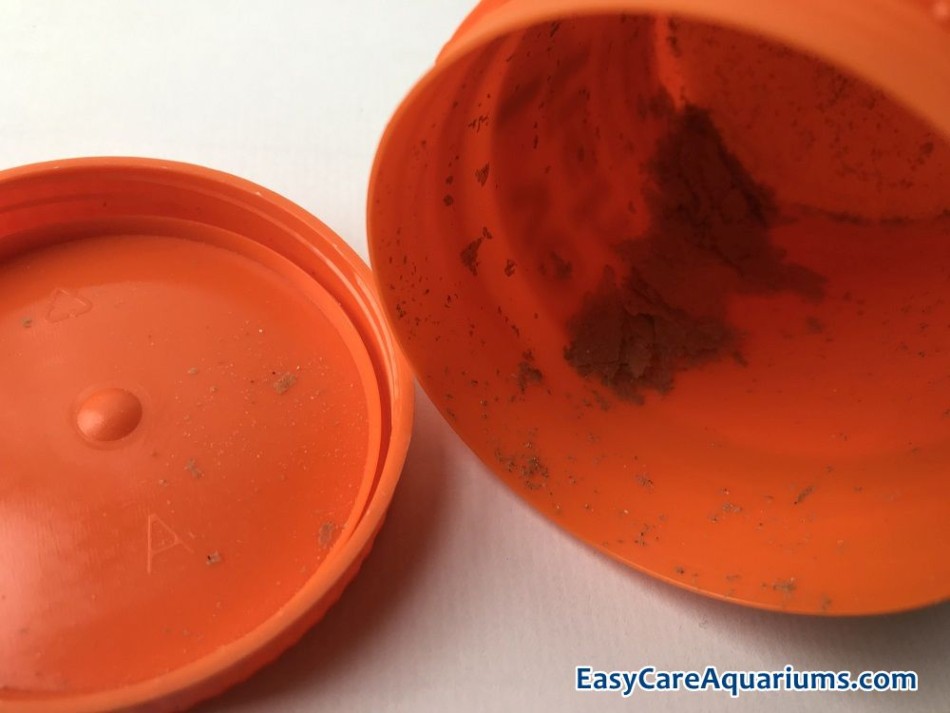
How Long Can Platy Fish Go Without Food?
Going without food for long periods of time is never a good idea whether you’re a Platy or a person. Unfortunately life doesn’t always run smoothly and meals can often be missed.
Fortunately Platys can be pretty resilient when it comes to a scant food supply.
And they can last for a surprisingly long time without a meal too.
While I would never recommend deliberately not feeding your Platy fish it is helpful to know how long they can survive without food. Just in case a situation comes up that means you’re unable to feed them for a while.
Adult Platys
It’s possible for an adult Platy to survive without food for between 1-2 weeks without any adverse effect to their health.
Although there are a few other factors involved that make this possible.
Your Platy fish would need to be well fed and healthy under normal circumstances. The tank conditions need to be clean, filtered, oxygenated and the appropriate size for the number of Platy.
If these conditions are met then your Platy fish can manage for a while if you have an emergency situation that means you can’t feed them for a few days.
Platy Fry
Unlike adult Platys their fry don’t do so well without regular feeds. Even if the tank conditions are optimal, Platy fry can only survive for about 3 days maximum without food.
Emergency situations can’t be planned for, and if you have no one who can step in and feed your fry while you’re unable to, you will need to be prepared for some losses in your aquarium.

